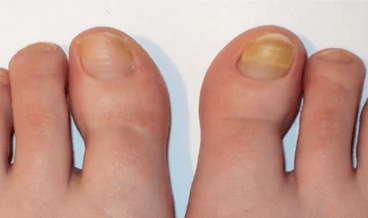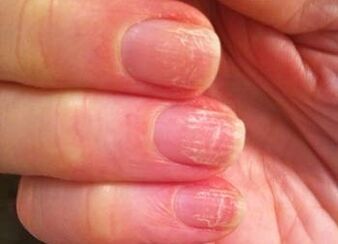
Mycosis, called fungal diseases in everyday life, have an infectious nature and are easily transmitted in contact with an infected, animal or object person.
Once on the skin or on the nail plate, the mushroom immediately begins to eat fabrics on which it appeared, gradually establishing more and more area.With its enzymes, the mushroom decomposes keratin, which is part of the tissues of the skin, hair and nails, that is, destroying them.
The mycosis of the nails in the initial phase differ only in a less evident manifestation.But the disease is homogeneous for the entire course of the course and the basis of the treatment used.
How the nail fungus begins: symptoms and photos
The beginning of the mycosis of the nails cannot always be seen by chance, since its manifestations can be insignificant.
The possible symptoms of this disease are as follows:
- Changing the color of the infected areas, often yellowed;
- the disappearance of the shine of the nails;
- the appearance of in relief spots, points or stripes on the nails;
- Type, swaying, fragility or peeling of infected areas;
- Partial destruction of the nail along the edges and the skin above the nail;
- itching or pain in infection;
- An unpleasant smell from the nails.
The listed phenomena may be both the symptoms of mycosis and a consequence of other factors, for example the following:
- Lack of vitamins and minerals;
- accumulation of dead or dirty skin;
- injuries;
- take some drugs;
- Non -infectious diseases: diabetes, psoriasis, eczema.
Therefore, for a careful diagnosis of mycosis, even in the presence of symptoms, a laboratory analysis of the fragment concerned of the nail plate is required.
Symptoms of the initial mushroom of the nails on the hands: photos

The mycosis of the nails in the hands is a little less common than the legs.
Its manifestations are the same:
- stench;
- itching and pain;
- Atrophy of the nail and skin plate on it;
- change in the shape and color of the nail plate;
- Loss with the nails of shine and a change in their color.
The same symptoms can indicate the following factors:
- Improper nutrition
- Long contact with detergents or chemical reagents
- Taking certain drugs
- Some diseases of a non -infectious nature.
Methods for the treatment of the initial nail fungus
It is necessary to treat fungal infections, since this not only ruins the appearance of the hands or feet, but also leads to a compromised immunity.As a result, people with mushrooms on nails are more inclined to colds, influence and other infectious diseases.
Any way to cure mycous for nails must necessarily include measures to prevent the re -infection.With the fabrics concerned, the mushroom falls on clothes, shoes and other objects to which the patient touches his fingers or legs.
Therefore, the following rules must be followed:
- The infected shoes that have been used before the start of the treatment are dealing with special means or throw it away.
- Before complete recovery, we wear cotton socks.
- Do not use slippers except those that are easy to wash (with a smooth internal surface).
- Change socks and gloves to clean every day and used to wash at high temperature and iron.
- It is advisable to treat shoes with ultraviolet anti -infusage lining during treatment.
According to representatives of professional medicine, the mycosa of the nails also in the initial phase requires systemic treatment in the first place and the outside in the second.The selection of drugs is made according to the type of existing mushroom.Laboratory tests can determine it.
- Anti -systemic or antifungal anti -inflammatory agents.They accumulate between the nails and stairs of the horn of the skin.By penetrating the mushroom in the cells, the active components of the drugs destroy their membrane or stop the synthesis of the substances with which it feeds.As a result, the mushroom dies.The treatment should last at least 3 months according to the following scheme: a week of admission, a three -week break;So repeat 2 times.Subsequently, for another six months, the drug will be present in the fabrics affected by the mushroom.Therefore, a healthy nail will have time to grow and the mushroom will not apply to it.The remaining treatment methods are used in addition to systemic therapy.The use of only local exposure methods can take care of the infection for some time, but in this case there is a risk of recurrence.
- Antifungal drugs of local use.These drugs soften to the consistency of the nails affected by plasticine.This effect allows you to easily remove the nails affected by the mushroom, accelerates the growth of the new nail and increases the effectiveness of systemic drugs.Antifungal agents are produced in the form of paints or ointments.Interested nails are covered in paint and the ordinary cosmetic paint is applied to the top.
- Medical pedicure.This method is the removal of the tissue tissue influenced by a mushroom and a soft adjustment of nails and feet with a special tool with many nozzles.The procedure lasts from 15 minutes to 2 hours and is performed 1-2 times a month.The duration of the treatment is from 3 months to one year.The medical pedicure is performed in specialized offices.Not only treats the infection, but also improves the appearance of the nails.After the first procedure, they seem much better.And the recovery signs become evident in the first 3 weeks of treatment.
- Ozonotherapy.The introduction of ozone into the soft tissues near the nails reduces inflammation in them and increases local immunity.The course of the treatment is at least 10 procedures that occupy up to 20 minutes each.1 - 2 times a week are kept.
- Traditional medicineIt offers the following method of treatment of the nail fungus.The following sequence of shares must be performed daily for at least 3 months or up to a complete recovery.The evening before going to bed, steam the legs or arms (depending on the position of the infection) in a solution of drinking soda with a temperature of 50 degrees.On each nail of the cottonary limb, apply cotton wool, well saturated with hydrogen peroxide or apple cider vinegar.Close the foot (brush) with a plastic wool with cellophane or glue them with a patch and go to bed.Throughout the treatment period, cut the nails as needed, as usual.
Prevention
Sources of mushroom infection are:
- public places where they go without shoes: bathrooms, saunas, showers, sports rooms, beaches;
- Public items: shoes (more often slippers), gloves (for example, boxing);
- rugs, more often in the bathrooms;
- Animals, including domestic and wool that have fallen from them;
- soil.
In order to minimize the probability of infection, it is necessary to observe the hygiene rules:
- If possible, avoid contacts with sources of infection, in particular wearing common shoes and clothes
- Don't wear tight shoes
- Apply Ultravioletti antifungal coatings for shoes in coexistence with a person suffering from mycosis.
You should know that mushrooms are able to come to life after several months of stay in a dried state.
The risk factors that are not amazed are the inheritance and growth of the slow nails.The mushroom is easier to spread through a nail that grows slowly.Its growth rate decreases with age.
Immunity in this disease does not play a significant role, since in the nail area it is much lower than most body systems.
Professional medicine successfully treats mycosis, both in the initial phase and after it.However, it is not possible to get rid of this disease without facing a specialist.



























